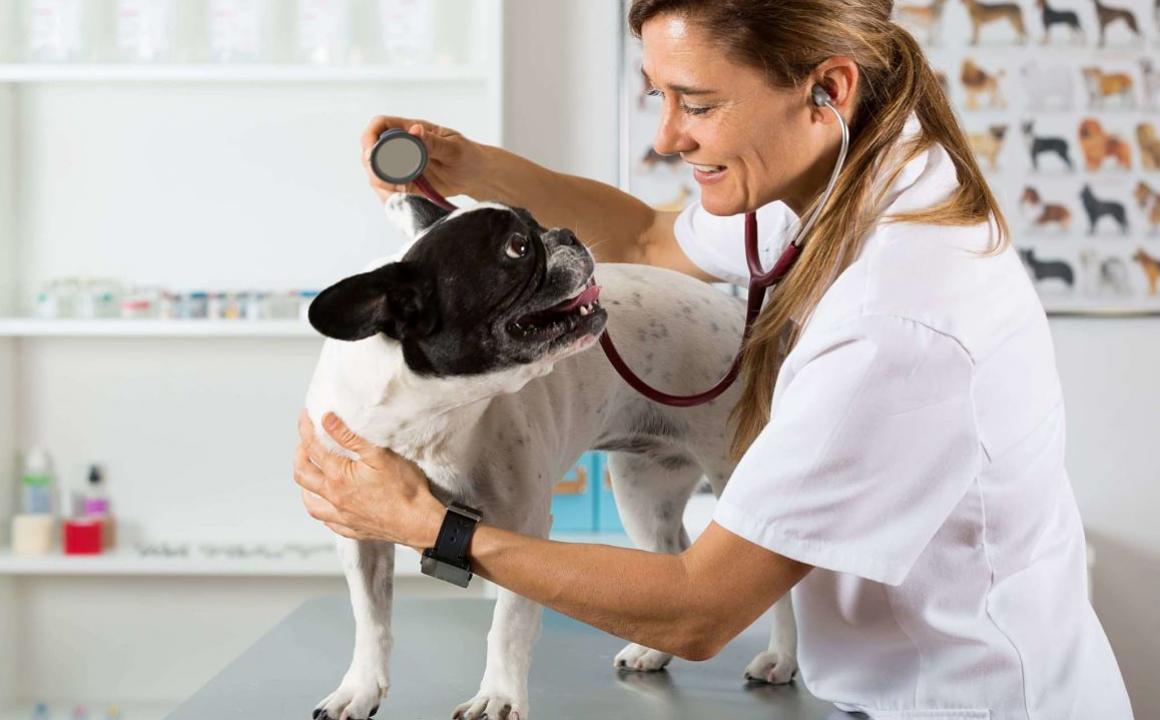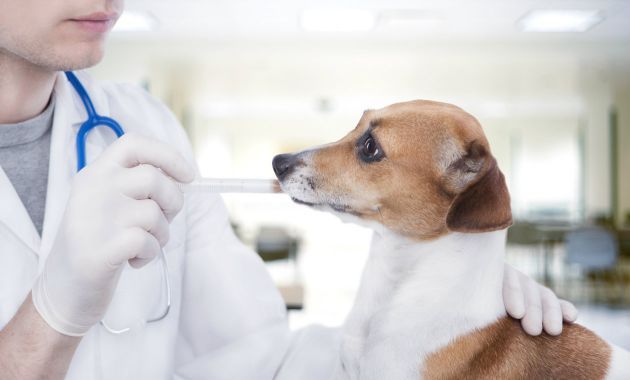Many times pets have diseases or symptoms that worry their owners, such is the case of fever in dogs, one of the most common symptoms and that often distresses as they do not find a quick solution, but do not worry here you will find all the information necessary.

Learn about fever in dogs
This is one of the conditions that most often afflicts dogs, which, as in humans, manifests itself from the increase in the normal temperature of dogs, which is between thirty-eight and thirty-five. nine degrees Celsius, and it can happen for various reasons such as; an infection.
On several occasions this cannot be seen with the naked eye, especially if your pet is not usually in physical contact with its owner, also when the person spends a lot of time away from home; But there are cases where the attitude of the dog can vary, making the person realize that there is something wrong with his pet.
In cases where you suspect that your pet has high temperatures, you can measure it using a digital thermometer, this will reflect the degrees it has to determine whether or not it has a fever.
It is important to note that if you notice that he has a high temperature and these persist for several days, do not hesitate to consult the veterinarian so that he can carry out the respective tests and what is causing these temperatures in your dog to be able to solve it with the respective measures as soon as possible. quickly as possible so that it does not get worse or progress.
What temperature is considered a fever in dogs?
This is a form of manifestation of other causative agents, so you should be aware of the high temperatures that it can present, as well as what may or may not persist, this symptom is considered to be a good defense mechanism that the body presents both humans as well as dogs and other animals.
It is good because in this way the immune system is seeking to definitively eliminate a pathogenic agent that is affecting it, which is why it is of great benefit as a manifesting reaction so that action can be taken more quickly.
A dog that is already in the adult stage can have an approximate temperature of 38 or 39 degrees, but this can vary, depending on a wide variety of aspects, such as the place where it is or the activity it performs, even so, once that the temperature is above thirty-nine degrees Celsius is where the dog is considered to have a fever.
It is considered an emergency when it reaches 41 degrees, at which time it should be taken to the vet for an evaluation and determination of what is ailing it.
It is important to note that there are puppies, as well as pregnant dogs and older dogs that can have large variations in their body temperature due to their condition. Even so, be careful if it is not able to regulate its temperature.
Causes of fever in dogs
Normally it is one of the biggest questions that arise when the dog has high temperatures, you want to know what is the cause to avoid on future occasions, what has generated it, but many times they are things that cannot be avoided, but arise for different reasons. circumstances and even by the place where the dog has been previously.
The causes of this agent can be diverse, although they are not always the same and can vary from one dog to another, so it is best to go to a specialist who will make the relevant evaluations, give a correct and safe diagnosis. It will also allow you to be medicated in the manner indicated for that condition.
Some of the causes of fever in dogs are as follows:
- Insolation: when these have been exposed for a long time to the sun's rays, fever can appear, for example, when they are taken to the beach and not placed in the shade.
- Poisoning: if they have been exposed to a toxic substance, a fever may have been generated that reflects that there are agents in their body, causing damage that is often irreversible.
- Postvaccinal reactions: If you have recently vaccinated your pet and it has a fever, you should not worry about the body's reaction to receiving that foreign substance.
- Parasites: when it has a parasite there are times when it manifests itself in this way, whether internal or external, as is the case with Ticks in dogs.
Symptoms of fever in dogs
As already mentioned, there are times when it is very difficult for a person to perceive that their pet has a fever, because they do not usually approach them or because they stay in remote areas of the home, however, there are always factors that can indicate that your dog has high temperatures, such as the following symptoms:
- When you touch their nose it is hot, always remember that the nose of these animals is cold, as if it were wet, so if the opposite happens when you touch it, take its temperature to see if it is stable or very high.
- He is apathetic, most dogs tend to show sympathy and joy in the presence of their owners, so if he is indifferent, does not wag his tail or stick out his tongue, it may be a sign that something is wrong with his temperature.
- Your dog is shivering, it usually happens the same as in people, they feel cold even when their temperature is high, if this happens, do not hesitate to use the thermometer to check and act immediately.
- It keeps sleeping, it can be a very representative sample, especially if it is usually very active and playful.
- He has become aggressive, perhaps his temperature makes him act this way, it makes him not feel well and he wants not to be bothered, on the contrary, to show him attention, so do not hesitate to check him if he acts so strange.
- He is vomiting frequently, if this happens you should take him to a doctor, since it may be a reflection of something more serious.
Other symptoms can be: diarrhea, runny nose, dry nose, sadness and anorexia; If any of the above is maintained for many days, go to a veterinarian for a pertinent review.
How to take a dog's temperature correctly?
A great question, there may be confusion in this, since we do not know whether to treat it the same as a person or act differently in them, however, do not worry below you will be able to see the different steps that must be carried out, to take the temperature in the dogs correctly and the result is truthful and timely:
Follow the steps below carefully:
The first thing you should do is have a digital thermometer at hand, preferably, since the rest do not work as well as in humans.
After you have it, you should proceed to relax your dog, no one but you will know how to do it perfectly, either through caresses, brushing his hair, giving him a toy, food or in any other way, this is done to prevent your dog hurting himself or moving around a lot while you take his temperature.
If you have already tried to calm him down in every possible way and you have not succeeded, then ask another person for collaboration so that they can hold him between them and carry out the task.
Once the pet is calm, place Vaseline on the thermometer, this is to make it less uncomfortable for the animal, you can also use another form of lubricant that you think is appropriate.
When you have lubricated it, you must introduce it in its anus, where it must remain for two minutes, the time will be indicated by the thermometer, if it does not have a stopwatch, keep track of it before removing it.
Observe the temperature that has been registered, if it is more than forty-one it is an emergency and you must go to the veterinarian, remember that you must disinfect the thermometer preferably with alcohol.
When a dog's temperature is low, is it a symptom of fever?
There are very specific cases where it can be observed that the temperature of the dog is below thirty-eight degrees Celsius, which is normal, reaching thirty-seven and even thirty-five, at which time it is before a case of hypothermia, just as it happens in people.
And just as when the case is, on the contrary, that is, when the temperatures are low, certain symptoms appear that indicate that something is not quite right in the dog, some of them can be:
His muscles are very stiff, which can be noticed when he walks, runs or even when he goes to bed, although you can also notice it when you touch him and he doesn't feel like he usually does.
Another symptom that can also be visible to the naked eye is the fact that they tremble a lot due to the low temperatures they are facing.
But also, they may be suffering from paused or slow breathing coupled with lethargy, so you should be aware of any of these symptoms, both the previous one and this one, both equally important and that should be acted upon immediately if you want to avoid further damage. serious.
Treatment for fever in dogs
It is important to note that you should never self-medicate your pet, many people make the serious mistake of giving medicines that other dogs were prescribed or there are even cases in which they return to providing treatment that had been previously prescribed, this being reckless and that can cause more serious damage; Treatments may vary depending on Characteristics of dogs.
With dogs, in this case, it happens the same as with humans, it is necessary to make a diagnosis through a previous evaluation that the veterinarian must do, according to what he determines, the appropriate treatment will be carried out for the condition that is afflicting to your dog.
There are cases in which the use of antibiotics is necessary, but everything will depend on the specific pathology; Regardless of what the vet prescribes for your dog, you must properly follow all the instructions, you must not exceed the dose or reduce it, and if you notice any side effects, do not hesitate to go quickly to a specialist.
When there are side effects, it may be that your dog is not accepting that medicine correctly, that he is allergic to it or to one of its components, so a change in treatment or a decrease in dose will be necessary.
How to lower a fever in a dog?
Always keep in mind that it is necessary that your dog's temperature should be kept at a normal level, it should not be overlooked or taken as a temporary situation, it is the same in them as in children and adults, they can quickly aggravate and often attract consequences that are irreversible for the health of the dog and its quality of life.
You should also know that there are medicines that are for humans and that cause harm to dogs, so you should avoid them, among some of them are ibuprofen and paracetamol, you should avoid providing them at low or all costs, what is most recommended is Get him to the vet as fast as you can.
If you can't go to the vet because it's too late, because you have children and you can't leave them alone or some other circumstance, then call the vet for advice on the matter or to attend your dog directly at home; he will surely ask you specific questions about the symptoms that he presents and about the habits that he is having.
Home remedies
Although it is not the most recommended, it is true that there are cases where it is impossible to go to a veterinarian, so it is necessary to take other measures to guarantee the well-being and quality of life of dogs, some tips that you can carry out from your case are the following:
Choose a towel or a sponge, you should wet it moderately, preferably wet, then you should place this in areas of your dog so that it cools down, it can be in the armpit area or on its abdomen; after you do this, wait about fifteen minutes and check if it has progressed or not, do not leave the rags on the dog for a long time.
Make sure your pet is always hydrated, if you see that it is not drinking water on its own then you must provide it through an injector, without a needle, fill it with water and then place it in its mouth expelling the water towards it; if she still rejects him then try giving her some broth with chicken substance.
After you do this, constantly check to see if it is really having an effect or not.
Prevention of fever in dogs
Above all, the most important thing is to prevent fever in dogs as well as other conditions, however, it should be noted that it is often impossible to prevent it, even so you could take into account the following tips:
Take your dog constantly to the vet, at least every six months or at most once a year, so many diseases can be avoided just as it occurs in humans.
Something extremely essential and that you must have very up to date in your dog are its vaccines, if you do not give them the dog will be more vulnerable to suffering from any condition.
Keep him dewormed, remember that in the world there are a lot of internal and external parasites that these animals can contract, but if you give him dewormer periodically then this will be a lower probability.
Do not forget to find out what foods dogs cannot eat, there are fruits that are allowed and others that are not, you should also know What vegetables can dogs eat?, which can poison him or keep him healthy, depending on what you feed him, not all food will keep him healthy.





